Borscht Belt
The Borscht Belt, or Yiddish Alps (as satirist Larry King called it), is a colloquial term for the mostly defunct summer resorts of the Catskill Mountains in parts of Sullivan, Orange, and Ulster counties in the U.S. state of New York, straddling both Upstate New York and the northern edges of the New York metropolitan area. A source interviewed by Time magazine stated that visits to the area by Jewish families were already underway "as early as the 1890s ... Tannersville ... was 'a great resort of our Israelite breathren [sic]'...from the 1920s on [there were] hundreds of hotels".[1]
Borscht Belt | |
|---|---|
Cultural region of United States | |
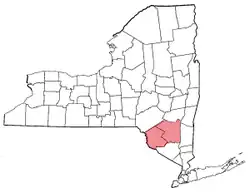 Areas of upstate New York that constituted the Borscht Belt | |
| Country | |
| State | |
A 2019 review of the history is more specific: "in its heyday, as many as 500 resorts catered to guests of various incomes".[2] These resorts, and also the Borscht Belt bungalow colonies, were a popular vacation spot for New York City Jews from the 1920s through the 1960s.[3] By the late 1950s, many began closing, with most gone by the 1970s, but some major resorts continued to operate, a few into the 1990s. Grossinger's Catskill Resort Hotel closed in 1986[4] and the Concord Resort Hotel struggled to stay open until 1998, and was subsequently demolished for a possible casino site.[2]
Name
The name comes from borscht, a soup of Ukrainian origin, made with beetroot as the main ingredient giving it a deep reddish-purple color,[5] that is popular in many Central and Eastern European countries and brought by Ashkenazi Jewish and Slavic immigrants to the United States. The name is a play on existing colloquial names for other American regions (such as the Bible Belt and Rust Belt). The name the Yiddish Alps was used (possibly coined) by Larry King and is satirical: a classic example of borscht belt humor.
History
In the 1920s and 1930s, some hotels and resorts' advertisements refused to accept Jews and indicated "No Hebrews or Consumptives" in their ads. This discrimination led to a need for alternative lodging that would readily accept Jewish families as guests. One report states that the larger hotels provided "Friday night and holiday services as well as kosher cooking."[6][7]
At the hotels, "food was of primary importance ... there was a sense that ‘too much was not enough'", according to one source.[8] "To understand the emphasis on food," writes Johnathan Sarna, "one has to understand hunger. Immigrants had memories of hunger, and in the Catskills, the food seemed limitless."[9]
The singles scene was also important; many hotels hired young male college students[10] to attract single girls of a similar age. One book on the era contended that the Catskills "became one great marriage broker."[11]
Borscht Belt hotels, bungalow colonies, summer camps, and kuchaleyns (a Yiddish name for self-catered boarding houses) flourished. The bungalows usually included "a kitchen/living room/dinette, one bedroom, and a screened porch" with entertainment being simple: bingo or a movie.[12] The kuchaleyns were also often visited by middle-class and working-class Jewish New Yorkers. Because of the many Jewish guests, this area was nicknamed the Jewish Alps and "Solomon County" (a modification of "Sullivan County") by many people who visited there.[13]
Borscht Belt resorts stood in towns such as Liberty, Fallsburg, Mamakating, Thompson, Bethel, and Rockland in Sullivan County as well as Wawarsing and Rochester in Ulster County. Such resorts included Avon Lodge, Brickman's, Brown's, Butler Lodge, The Concord, Grossinger's, Granit, the Heiden Hotel, Irvington, Kutsher's Hotel and Country Club, the Nevele, Friar Tuck Inn, the Laurels Hotel and Country Club, the Pines Resort, Raleigh Hotel, the Overlook, the Tamarack Lodge, Shady Nook Hotel and Country Club, Stevensville, Stier's Hotel, and the Windsor. Some of these hotels originated from farms that Jewish immigrants established in the early part of the 20th century.[14]
Two of the larger hotels in High View (just north of Bloomingburg) were Shawanga Lodge and the Overlook. One of the high points of Shawanga Lodge's existence came in 1959 when it was the site of a conference of scientists researching laser beams. The conference marked the start of serious research into lasers.[15] The hotel burned to the ground in 1973.[16]
The Overlook, which offered entertainment and rooms, as well as bungalows, was operated by the Schrier family.[2]
The Granit Hotel and Country Club, located in Kerhonkson, boasted many amenities, including a golf course. It closed in 2015, and was renovated and turned into the Hudson Valley Resort and Spa, which closed in 2018. The property was sold in May 2019 to Hudson Valley Holding Co. LLC. The company did not announce its plans for the hotel.[17]
 Brown's hotel, 1977
Brown's hotel, 1977 A view from the Granit hotel, 1977
A view from the Granit hotel, 1977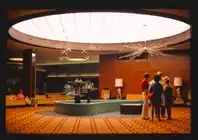 The Nevele hotel lobby, 1978
The Nevele hotel lobby, 1978 A room at Kutcher's, 1977
A room at Kutcher's, 1977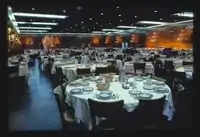 The Concord dining room, 1978
The Concord dining room, 1978 Brickman's pool area, 1977
Brickman's pool area, 1977 Grossinger's ping pong, 1977
Grossinger's ping pong, 1977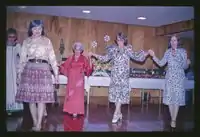 Folk dancing party at Menges' Lakeside, 1977
Folk dancing party at Menges' Lakeside, 1977
Decline
According to Time, "the Borscht Belt resorts reached their peak in the 1950s and 60s, accommodating up to 150,000 guests a year" but the start of a decline was apparent by the late 1960s. "Railways began cutting service to the area, the popularity of air travel increased, and a younger generation of Jewish-Americans chose other leisure destinations."[18] Another source mentions a secondary factor: "anti-Semitism declined, so Jews could go other places".[19]
Access to the area improved with the opening of the George Washington Bridge and upgrade of old travel routes such as old New York State Route 17. On the other hand, passenger train access ended with the September 10, 1953 termination of passenger trains on the Ontario and Western Railway mainline from Roscoe at the northern edge of Sullivan County, through the Borscht Belt, to Weehawken, New Jersey.[20] A 1940 vacation travel guide published by the railroad listed hundreds of establishments that were situated at or near the railway's stations.[21] The following year the New York Central ceased running passenger trains on its Catskill Mountain Branch.[22] The area suffered as a travel destination in the late 1950s and especially by the 1960s. Another source also confirms that "cheap air travel suddenly allowed a new generation to visit more exotic and warmer destinations".[23] More women remained in the workforce after marriage and could not take off for the entire summer to relocate to the Catskills.[24]
According to a recent source, by the early 1960s, some 25 to 30 percent of Grossinger's visitors were not Jewish.[2]
A Times of Israel article specifies that "the bungalow colonies were the first to go under, followed by the smaller hotels. The glitziest ones hung on the longest" with some continuing to operate in the 1980s and even in the 1990s.[8] The Concord, which outlasted most other resorts, went bankrupt in 1997 but survived until 1998.[2]
In 1987, New York's mayor Ed Koch proposed buying the Gibber Hotel in Kiamesha Lake to house the homeless. The idea was opposed by local officials.[25] The hotel instead became the religious school Yeshiva Viznitz.[26]
21st century
The Heiden Hotel in South Fallsburg, the location of the 1987 movie Sweet Lorraine starring Maureen Stapleton, was destroyed by fire in May 2008.[27]
The Stevensville Hotel in Swan Lake, owned by the family of accused Bernard Madoff accomplice David G. Friehling, reopened as the Swan Lake Resort Hotel.[28]
The former Homowack Lodge in Phillipsport was converted into a summer camp for Hasidic girls. Officials of the state Department of Health ordered the property evacuated in July 2009, citing health and safety violations.[29]
Many Buddhist and Hindu retreat centers have been constructed on the land or in the restored buildings of former camps or resorts to serve adherents in New York City, the establishment of which has then drawn even more temples and centers to the area. This led to the coining of the nickname 'Buddha Belt', 'Bhajan Belt', or 'Buddhist Belt' to refer to the area's revival.[30][31][32]
Between 2013 and 2018 the decaying state of the abandoned resorts was captured by several ruins photographers:[33][34][23][35]
- The Flagler Hotel, Nemerson, Schenk's and Windsor Hotels in South Fallsburg, and the Stevensville Hotel in Swan Lake, were converted into Jewish religious summer camps.
- Grossinger's Catskill Resort Hotel; the Grossinger's complex partially was demolished in 2018 and a new owner planned to build a hotel, homes and other amenities. A remaining structure on the property was destroyed by fire in August 2022.[36][37]
- The former Gilbert's Hotel and Brickman Hotel are not part of the Siddha Yoga SYDA complex. A gift shop remains open at the sites, which are not in current active use.
- Lesser Lodge
- Nevele Grand Hotel
- The Vegetarian Hotel
- Kutsher's Hotel and Country Club; a wellness club was built on the site; it opened in June 2018.[38][39] The original Kutcher's nightclub is all that remains of the original hotel. The Kutcher's Hotel front electric sign was donated to the Sullivan County Historical Museum.
- The Pines Hotel golf course was converted into a Jewish religious housing site. The Pines Hotel dilapidated main building and surrounding structures remained in a state of decay until it was destroyed in a fire in 2023.[40]
- White Lake Mansion House
- Homowack Lodge
- Tamarack Lodge
- Concord Resort Hotel; In February 2018, Resorts World Catskills opened on the site of the old hotel.
- Abandoned hotel buildings
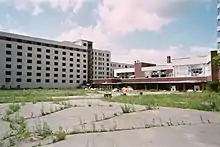 The Concord hotel, 2005
The Concord hotel, 2005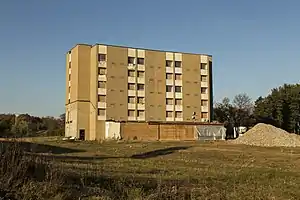 Kutcher's hotel, 2015
Kutcher's hotel, 2015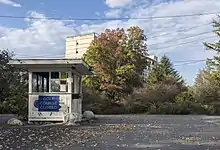 Grossinger's resort, 2015
Grossinger's resort, 2015 The Granit resort, 2015
The Granit resort, 2015
As of the 2010s, the region is a summer home for many Orthodox Jewish families.[41] Some of the hotels have been converted into rehab centers, meditation centers or Orthodox Jewish hotels and resorts.[42] The Orthodox Jews who flock to the region each summer provide commerce that the area would not have otherwise.[41]
Comedic legacy

The tradition of Borscht Belt entertainment started in the early 20th century with the indoor and outdoor theaters constructed on a 40-acre (16-hectare) tract in Hunter, New York by Yiddish theater star Boris Thomashefsky.
A cradle of American Jewish comedy since the 1920s, the Borscht Belt entertainment circuit has helped launch the careers of many famous comedians and acted as a launchpad for those just starting out.[43]
Comedians who got their start or regularly performed in Borscht Belt resorts include:
- Joey Adams
- Woody Allen
- Morey Amsterdam
- Sandy Baron
- Benny Bell
- Milton Berle
- Shelley Berman
- Mel Brooks
- Lenny Bruce
- George Burns
- Red Buttons
- Sid Caesar
- Jean Carroll
- Jack Carter
- Myron Cohen
- Bill Dana
- Rodney Dangerfield
- Phyllis Diller
- Totie Fields
- Betty Garrett
- Estelle Getty
- George Gobel
- Gretchen Grape
- Shecky Greene
- Buddy Hackett
- Mickey Katz
- Danny Kaye
- Alan King
- Robert Klein
- Jack E. Leonard
- Pesach Burstein
- Mal Z. Lawrence
- Sam Levenson
- Jerry Lewis
- Jackie Mason
- Lou Menchell
- Jan Murray
- Freddie Prinze Sr.
- Carl Reiner
- Don Rickles
- Joan Rivers
- Freddie Roman
- Allan Sherman
- Jackie Vernon
- Murray Waxman
- Jonathan Winters
- Henny Youngman
Borscht Belt humor refers to the rapid-fire, often self-deprecating style common to many of these performers and writers. Typical themes include:
- Bad luck
- Puns: "Sire, the peasants are revolting!" "You said it. They stink on ice." (Harvey Korman as Count de Money (Monet) and Mel Brooks as King Louis XVI, in History of the World Part I)
- Physical complaints and ailments (often relating to bowels and cramping): "My doctor said I was in terrible shape. I told him, 'I want a second opinion.' He said, 'All right, you're ugly too!'" "I told my doctor, 'This morning when I got up and saw myself in the mirror, I looked awful! What's wrong with me?' He replied, 'I don't know, but your eyesight is perfect!'" (Dangerfield)
- Aggravating relatives and nagging wives: "My wife and I were happy for twenty years. Then we met." (Dangerfield). "Take my wife—please!" (Henny Youngman); "My wife drowned in the pool because she was wearing so much jewelry." (Rickles); "My wife ain't too bright. One day our car got stolen. I said to her, 'Did you get a look at the guy?' She said, 'No, but I got the license number.'" (Dangerfield) "This morning the doorbell rang. I said 'Who is it?' She said 'It's the Boston Strangler.' I said 'It's for you dear!'" (Youngman)
References
- Rothman, Lily (December 6, 2018). "The Real History Behind The Marvelous Mrs. Maisel's Trip to the Catskills 'Borscht Belt'". Time.
- Turkel, Stanley (1 August 2019). "Nobody Asked Me, But… No. 217, Hotel History: Catskill Mountain Resort Hotels". Hospitality Net.
- "Jewish scholars study history, cultural significance of the Borscht Belt" (Press release). Providence, Rhose Island: Brown University. Archived from the original on December 3, 2019.
- "Ruins of Grossinger's Resort". Atlas Obscura. August 24, 2013.
[...] the hotel closed it's [sic] doors for the last time in 1986.
- Schultze, Sydney (2000). Culture and Customs of Russia. Series: Cultures and Customs of the World. Greenwood. pp. 65–66. ISBN 978-0313311017.
The very poor might have few vegetables in the soup other than cabbage, making it shchi, or if it also had beets it was considered borscht. Borscht, actually Ukrainian in origin....
- Jankovitz, Michael (November 26, 2014). "Spotlight on Nostalgia". Baltimore Jewish Times.
- Barken, Jeffrey F. (November 26, 2014). "Kutsher's Documentary Captures Eclectic Legacy Of Borscht Belt Relic". Jewish Business News. Archived from the original on 2014-12-23.
- Kirshner, Sheldon (September 25, 2018). "The Bygone Era of the Jewish Catskills Resorts". The Times of Israel.
- Silverman, Stephen M.; Silver, Raphael D. (2015). The Catskills: Its History and How It Changed America. p. 303. ISBN 9780307272157.
- Post, Marlene (2019-09-03). "Remembering Summers and Honeymoons in the Mountains". Hadassah Magazine.
- Silverman, Stephen M.; Silver, Raphael D. (2015). The Catskills: Its History and How It Changed America. p. 9. ISBN 9780307272157.
- Shapiro, Marilyn (March 15, 2019). "Borscht Belt staff reminisce about the glory days of the Jewish Alps and their part in making it happen". The Jewish World. Archived from the original on October 27, 2021. Retrieved March 12, 2021.
- Stone, Emily (2013). "From the Catskills to California: How the Borscht Belt Went From Lo Pro to High Ho and the West Was Won". Did Jew Know?: A Handy Primer on the Customs, Culture & Practice of the Chosen People. p. 160. ISBN 9781452129570.
- Finkelstein, Norman H. (2014-01-01). Jewish Comedy Stars: Classic to Cutting Edge. Kar-Ben Publishing ™. ISBN 978-1-5124-9029-9.
- Hecht, Jeff (2005). Beam: the race to make the laser. Oxford University Press. p. 101. ISBN 9780195142105.
- "Mamakating" by Monika A. Roosa, Arcadia Publishing, 2007, p. 29
- Doxsey, Patricia (May 7, 2019). "Hudson Valley Resort and Spa, closed since October 2018, bought by Brooklyn group". Daily Freeman.
- Clusiau, Christina (June 23, 2011). "The Disappearance of the Borscht Belt Hotels". Time.
- Levine, David (July 23, 2014). "History of Borscht Belt Hotels and Bungalow Colonies in the Catskills". Hudson Valley Magazine.
- Burns, Adam (July 3, 2022). "New York, Ontario & Western Railway (NYO&W): "Route Of The Mountaineer"". American Rails.
- "1940 Vacation Guide - New York Ontario and Western Railway". The Catskills Institute. Northeastern University. Retrieved 21 January 2022.
- "1954 Chronology of the Pennsylvania Railroad Company and its Historical Context" (PDF). PRR Chronology. Pennsylvania Railroad Technical and Historical Society. Retrieved 12 February 2022.
- Willett-Wei, Megan; Lakritz, Talia (July 5, 2018). "23 eerie photos that show the crumbling beauty of New York's abandoned 'Borscht Belt' resorts". Business Insider.
- Danailova, Hiliary (September 3, 2019). "Young Jews Are Bringing the Catskills Back to Life". Hadassah Magazine.
- Purnick, Joyce (1987-04-04). "Catskills Hotel Suggested For Homeless". The New York Times. Retrieved 2010-04-26.
- "Hotels and Bungalows". Providence, Rhode Island: The Catskills Institute, Brown University. Archived from the original on January 30, 2019. Retrieved June 28, 2020.
- "Overnight Fire Destroys Heiden Hotel of 'Sweet Lorraine' fame". Times Herald-Record. Middletown, New York. May 18, 2008. Archived from the original on September 1, 2019. Retrieved June 28, 2020.
- Israel, Steve (March 22, 2009). "Madoff mess has local link". Times Herald-Record. Middletown, New York. Archived from the original on September 1, 2019. Retrieved 2010-06-09.
- Whitman, Victor (2009-07-16). "New York wants sect to leave old resort". Times Herald Record. Middletown, New York. Archived from the original on June 28, 2020. Retrieved 2009-07-17.
- Healy, Mark (2002-10-18). "HAVENS; The 'Bhajan Belt': Serenity in the Catskills". The New York Times. Retrieved 2020-09-24.
- Sullivan, John (2007-08-19). "region's 'buddha belt' keeps on expanding". Times Herald-Record. Retrieved 2020-09-24.
- Brown, Rande (Winter 2003). "Borscht Belt Buddhism". Tricycle: The Buddhist Review. Retrieved 2020-09-24.
- Frankfurter, Yitzchok (Sep 15, 2013). "Ruins of the Borscht Belt: A Photo Essay and Conversation with Documentary Photographer Marisa Scheinfeld". Ami Magazine. No. 136. p. 167. Retrieved Feb 21, 2023.
- Cabrey, Erin (5 October 2017). "10 Abandoned Resorts from The Borscht Belt, America's Jewish Vacationland in Catskills, New York". Untapped Cities. Retrieved 16 January 2022.
- Scheinfeld, Marisa; Kanfer, Stefan; Weissman Joselit, Jenna (15 November 2016). The Borscht Belt: Revisiting the Remains of America's Jewish Vacationland. Ithaca, New York: Cornell University Press. ISBN 9781501700590.
- Nanci, Matthew (February 11, 2019). "Possible revival of Grossinger's Resort moves ahead". Archived from the original on 2019-02-12.
- "Building at the Catskills' famed Grossinger's resort, an inspiration for "Dirty Dancing," burns down in massive fire". CBS News.
- Nanci, Matthew (June 21, 2018). "High-end wellness resort opens in Sullivan County". Times Herald-Record. Archived from the original on 2021-08-02.
- "LeCHASE: YO1 Luxury Nature Cure".
This six-story, 295,000 SF wellness resort was built on the former Kutsher's Country Club property in Monticello, NY.
- "CATSKILLS: Abandoned Pines Hotel Destroyed in Massive Blaze". The Yeshiva World. 18 June 2023. Retrieved 18 June 2023.
- Frankfurter, Yitzchok (Sep 15, 2013). "Ruins of the Borscht Belt: A Photo Essay and Conversation with Documentary Photographer Marisa Scheinfeld". Ami Magazine. No. 136. p. 172. Retrieved Feb 21, 2023.
- Frankfurter, Yitzchok (Sep 15, 2013). "Ruins of the Borscht Belt: A Photo Essay and Conversation with Documentary Photographer Marisa Scheinfeld". Ami Magazine. No. 136. p. 176.
- "Yada Yada Yada: 15 Greatest Moments in Jewish Comedy History". Tel Aviv, Israel: Museum of the Jewish People at Beit Hatfutsot. December 18, 2018. Archived from the original on June 28, 2020.
External links
- The Catskills Institute at Northeastern University
- Van Ells, Mark D. (Spring 2007). "The Rise and Fall of the Borscht Belt (Review)". Film & History. Center for the Study of Film and History. 37 (1): 80. doi:10.1353/flm.2007.0011. S2CID 201796384. Archived from the original on June 3, 2018.
- Four Seasons Lodge, a documentary about a bungalow colony of Holocaust survivors in the Catskills
- The Forgotten Borscht Belt and The Summer Resorts of the Catskills on YouTube. Drone Video footage of The Pines and Grossinger's.
- The Borscht Belt: Visiting the Remains of America's Jewish Vacationland